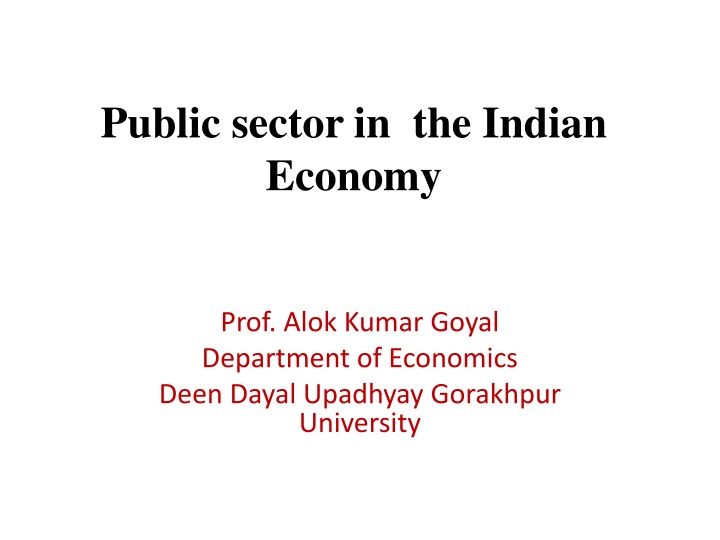
Role of Public Sector in Indian Economy
The public sector in the Indian economy plays a vital role in capital formation, infrastructure development, strengthening the industrial base, achieving economies of scale, reducing regional disparities, and more. It has contributed significantly to the overall economic growth and development of the country.
Download Presentation

Please find below an Image/Link to download the presentation.
The content on the website is provided AS IS for your information and personal use only. It may not be sold, licensed, or shared on other websites without obtaining consent from the author. If you encounter any issues during the download, it is possible that the publisher has removed the file from their server.
You are allowed to download the files provided on this website for personal or commercial use, subject to the condition that they are used lawfully. All files are the property of their respective owners.
The content on the website is provided AS IS for your information and personal use only. It may not be sold, licensed, or shared on other websites without obtaining consent from the author.
E N D
Presentation Transcript
Public sector in the Indian Economy Prof. Alok Kumar Goyal Department of Economics Deen Dayal Upadhyay Gorakhpur University
Public Sector in the Indian Economy The structure of the Indian economy is characterised as Mixed Economy. There are two fields of production: 1. Private Sector 2. Public Sector
Private and Public Sectors 1. At time of independence, public sector were restricted to infrastructure (irrigation, power, railways, ports, communications) and some departmental undertakings. 2. After independence, area of activities of public sector were expanded at very rapid speed due to adoption of socialistic pattern development in industrial policies 1948 and 1956. 3.Basic and heavy industries were kept for public sector and the entire field of consumers goods industries, which are having high & early returns, were left to the private sector. 4. Division of the industrial activities were based on two hypothesis:
Private and Public Sectors a). Private investment was in the nature of induced investment and profit oriented in short period of time. In this regard, consumer goods industries were suitable for private sector. b). Basic and heavy industries were required for heavy investment, long gestation period, low or no profit, a large forex components and complex technology with complex coordination also. The nature of investment in these types of activities were inducing investment and inducing investments were possible for public sector.
Role of Public Sector in Indian Economy 1). Public sector and Capital formation 2). Development of infrastructure 3). Strong industrial base 4). Economies of scale 5). Removal of regional disparities 6). Import substitution and export promotion 7). Check over concentration of economic power
Role of Public Sector in Indian Economy 1). Public sector and Capital formation: During the first and second plans, 54% was in the public sector of total investment and rose to 60% in the third plan but fell thereafter. 2). Development of infrastructure: Public sector has enabled the economy to develop a strong infrastructure( transports, communication, fuel and energy, basic and heavy industries) for the future economic growth. 3). Strong industrial: The Govt has strengthened the industrial base considerably by placing due emphasis on the setting up of industries as like iron and steel, heavy engineering , coal, heavy electrical machinery, petroleum and natural gas, chemical and drugs , fertilizers etc.
Contd. 4). Economies of scale: The industries, which create external economy for other industries or generate linkage effect but required large capital and possibility of low returns with long gestation period , were developed under public sector. These types of industries could not established and developed under market economy ( Private sector). of scale 5). Removal of regional disparities: Public sector unites play a vital role in removal of regional disparities. During the plan period, the major of public sector investment was directed towards backward states- Bhilai steel plant in Chhattisgarh, Rourkela steel plant in Orissa, Durgapur steel plant in West Bengal and Bokaro steel plant in Jharkhand. 6). Import substitution and export promotion: Public sector industries have played important role for import substitution and export promotion policy of foreign trade. Such types of public sector industries are BHEL, IOC, ONGC, HAL, BEL, Hindustan Machine Tools, Hindustan Steel td. etc . 7). Check over concentration of economic power: Reducing inequalities in society is an important component of economic development. In this regard, expansion of public sector helped to brake the tendency towards economic concentration in Indian economy.
Performance Criteria of PSUs Profitability criteria is sufficient to check the performance of private sector but not sufficient to check the performance of public sector. Because public sector undertakings are frequently started in those sector, where profitability is low and long gestation period. Public sector industries create the basis for expansion of industrial activities and provide inputs to private sector. In some cases, public sector has monopoly in production and has chance to hike their product s prices. However, even then public sector has not been goal of profit maximisation and opt public utility approach for pricing for accelerating the process of industrialization in the country. Performance of the public sector units should not be judged by what they earn in the form of profit but by total additions they make to the flow of goods services in the economy.
Performance Criteria of PSUs 1.Profitability and Efficiency: Efficiency can not be measured by profitability in case of public sector. 2.Employment and Labour Welfare: Public sector set a model for good employer and provide facilities to employees for labour welfare maximisation. 3.Expansion of Public Sector s Share in National Income: 4.Public Sector and Foreign Exchange
Contd.. 3.Expansion of Public Sector s Share in National Income:
Contd.. 4.Public Sector and Foreign Exchange: As far as foreign exchange earning are concerned, the public sector has contributed in three ways: a). Through direct export of the items produced by public sector, b).Through services rendered by public sector undertakings c). Through trading and marketing services of the undertakings through which export are canalised.
Problems of PSUs 1.Price Policy of Public Sector Enterprises 2. Under Utilization Capacity 3. Planning and Construction of Projects 4. Labour, Personnel and management
Problems of PSUs 1.Price Policy of Public Sector Enterprises a) Public Utility Approach: No profit no loss situation ( Break even point)- This pricing policy was followed for a long period by many public sector enterprises. b) Rate of Return Approach: To generate re-investable capital surplus situation not for profit maximisation c) Import Parity price: For the purpose of import substitution The crux of the poor financial returns lies in incorrect pricing of these services and poor collection of the user charges.
Problems of PSUs 2. Under Utilization Capacity: The factors responsible for under utilization capacity are following: a) Instruments for meeting immediate or ad hoc demand for mass consumption goods b) Stimulating growth in economically backward area c) Using locally available raw materials d) Poor Quality e) Inefficient operation f) Poor Management g) Political Interference in day to day working
Problems of PSUs 3. Planning and Construction of Projects a) Selection of site was not based on detailed soil investigation b) There were serious omissions and understatements of several elements of the projects: c) The actual cost of projects far exceeded the original estimates d) The projects took much longer time to complete than originally envisaged e) The projects often embodied inappropriate technology or product mix
Problems of PSUs 4.Labour, Personnel and management: Public sector enterprises are often plagued with undue political interference in their day to day working and this has demoralising effect on the management and other personnel of these enterprises. Political considerations have also contributed to overstuffing of unskilled labour and payment of higher wages to such labour than in the private sector.
Policy Towards PSUs since 1991 1. Dereservation policy: At present only 2 industrial sectors are reserved for public sector- atomic energy and railway operations. 2. Disinvestment policy: Disinvestment is the process through which privatisation could take place. Government sell stakes of public sector companies to private sector using different methods. 3. Policy towards sick public sector enterprises. In 2004, Board for Reconstruction of Public Sector Enterprises (BRPSE) was set up for the recommendation of disinvestment, closure or sale to PSUs. 4. Memorandum of understanding : It gives clear targets to PSUs and ensures operational autonomy to them for achieving those targets. On the basis of degree of operation autonomy, CPSEs are categorised into Navratnas, Maharatnas and Miniratnas.
References 1) V K Puri & S K Misra: Indian Economy, HPH 2) Datt & Sundharam: Indian Economy, S Chand & Compy.






















